Exploring the Efficacy of Binary Surveys versus Likert Scales in Assessing Student Perspectives Using Bayesian Analysis
Abstract
:1. Introduction
2. Methodology
2.1. Survey
2.2. Data Pre-Processing
2.3. Likert–Dichotomous Conversion
2.4. Bayes Factors
3. Results
3.1. Likert–Dichotomous Conversion
3.2. Bayes Factor
3.3. Student Opinions
4. Conclusions
Author Contributions
Funding
Institutional Review Board Statement
Informed Consent Statement
Data Availability Statement
Acknowledgments
Conflicts of Interest
References
- Van Der Eijk, C. Measuring Agreement in Ordered Rating Scales. Qual. Quant. 2001, 35, 325–341. [Google Scholar] [CrossRef]
- Dolnicar, S. Asking Good Survey Questions. J. Travel Res. 2013, 52, 551–574. [Google Scholar] [CrossRef]
- Johnson, M.D.; Lehmann, D.R.; Horne, D.R. The Effects of Fatigue on Judgments of Interproduct Similarity. Int. J. Res. Mark. 1990, 7, 35–43. [Google Scholar] [CrossRef]
- Drolet, A.L.; Morrison, D.G. Do We Really Need Multiple-Item Measures in Service Research? J. Serv. Res. 2001, 3, 196–204. [Google Scholar] [CrossRef]
- Komorita, S.S.; Graham, W.K. Number of Scale Points and the Reliability of Scales. Educ. Psychol. Meas. 1965, 25, 987–995. [Google Scholar] [CrossRef]
- Martin, W.S.; Fruchter, B.; Mathis, W.J. An Investigation of the Effect of the Number of Scale Intervals on Principal Components Factor Analysis. Educ. Psychol. Meas. 1974, 34, 537–545. [Google Scholar] [CrossRef]
- Grassi, M.; Nucera, A.; Zanolin, E.; Omenaas, E.; Josep; Anto, M.; Leynaert, B. Performance Comparison of Likert and Binary Formats of SF-36 Version 1.6 across ECRHS II Adults Populations. Value Health 2007, 10, 478–488. [Google Scholar] [CrossRef]
- Dolnicar, S.; Grün, B. How Constrained a Response: A Comparison of Binary, Ordinal and Metric Answer Formats. J. Retail. Consum. Serv. 2007, 14, 108–122. [Google Scholar] [CrossRef]
- Zax, M.; Takahashi, S. Cultural Influences on Response Style: Comparisons of Japanese and American College Students. J. Soc. Psychol. 1967, 71, 3–10. [Google Scholar] [CrossRef] [PubMed]
- Paulhus, D.L. Measurement and Control of Response Bias. In Measures of Personality and Social Psychological Attitudes; Elsevier: Amsterdam, The Netherlands, 1991; pp. 17–59. [Google Scholar] [CrossRef]
- Welkenhuysen-Gybels, J.; Billiet, J.; Cambré, B. Adjustment for Acquiescence in the Assessment of the Construct Equivalence of Likert-Type Score Items. J. Cross-Cult. Psychol. 2003, 34, 702–722. [Google Scholar] [CrossRef]
- Fisher, R.A. Statistical Methods for Research Workers. In Breakthroughs in Statistics; Kotz, S., Johnson, N.L., Eds.; Springer Series in Statistics; Springer: New York, NY, USA, 1935; pp. 66–70. [Google Scholar] [CrossRef]
- Nuzzo, R. Scientific Method: Statistical Errors. Nature 2014, 506, 150–152. [Google Scholar] [CrossRef]
- Altman, D.G.; Bland, J.M. Statistics Notes: Absence of Evidence Is Not Evidence of Absence. BMJ 1995, 311, 485. [Google Scholar] [CrossRef]
- Mark, A.; Baguley, T. Prior Approval: The Growth of Bayesian Methods in Psychology. Br. J. Math. Stat. Psychol. 2013, 66, 1–7. [Google Scholar] [CrossRef] [PubMed]
- Kruschke, J.K.; Aguinis, H.; Joo, H. The Time Has Come. Organ. Res. Methods 2012, 15, 722–752. [Google Scholar] [CrossRef]
- Wagenmakers, E.-J.; Morey, R.D.; Lee, M.D. Bayesian Benefits for the Pragmatic Researcher. Curr. Dir. Psychol. Sci. 2016, 25, 169–176. [Google Scholar] [CrossRef]
- Dienes, Z.; Mclatchie, N. Four Reasons to Prefer Bayesian Analyses over Significance Testing. Psychon. Bull. Rev. 2018, 25, 207–218. [Google Scholar] [CrossRef]
- Makowski, D.; Ben-Shachar, M.S.; Chen, S.H.A.; Lüdecke, D. Indices of Effect Existence and Significance in the Bayesian Framework. Front. Psychol. 2019, 10, 2767. [Google Scholar] [CrossRef] [PubMed]
- Simmons, J.P.; Nelson, L.D.; Simonsohn, U. False-Positive Psychology. Psychol. Sci. 2011, 22, 1359–1366. [Google Scholar] [CrossRef]
- Szucs, D.; Ioannidis, J.P.A. Empirical Assessment of Published Effect Sizes and Power in the Recent Cognitive Neuroscience and Psychology Literature. PLoS Biol. 2017, 15, e2000797. [Google Scholar] [CrossRef]
- Kass, R.E.; Raftery, A.E. Bayes Factors. J. Am. Stat. Assoc. 1995, 90, 773–795. [Google Scholar] [CrossRef]
- Morey, R.D.; Romeijn, J.-W.; Rouder, J.N. The Philosophy of Bayes Factors and the Quantification of Statistical Evidence. J. Math. Psychol. 2016, 72, 6–18. [Google Scholar] [CrossRef]
- Kruschke, J.K. Rejecting or Accepting Parameter Values in Bayesian Estimation. Adv. Methods Pract. Psychol. Sci. 2018, 1, 270–280. [Google Scholar] [CrossRef]
- De Bragança Pereira, C.; Stern, J. Evidence and Credibility: Full Bayesian Significance Test for Precise Hypotheses. Entropy 1999, 1, 99–110. [Google Scholar] [CrossRef]
- Kelter, R. Analysis of Bayesian Posterior Significance and Effect Size Indices for the Two-Sample t-Test to Support Reproducible Medical Research. BMC Med. Res. Methodol. 2020, 20, 88. [Google Scholar] [CrossRef]
- Capik, C.; Gozum, S. Psychometric features of an assessment instrument with likert and dichotomous response formats. Public Health Nurs. 2015, 32, 81–86. [Google Scholar] [CrossRef]
- Lee, J.W.; Jones, P.S.; Mineyama, Y.; Zhang, X.E. Cultural differences in responses to a Likert scale. Res. Nurs. Health 2002, 25, 295–306. [Google Scholar] [CrossRef]
- Wrinch, D.; Jeffreys, H. On Certain Fundamental Principles of Scientific Inquiry, (Second Paper). Lond. Edinb. Dublin Philos. Mag. J. Sci. 1923, 45, 368–374. [Google Scholar] [CrossRef]
- Jeffreys, H. Theory of Probability (Oxford Classic Texts in the Physical Sciences); Paperback; Oxford University Press: Oxford, UK, 1998. [Google Scholar]
- Kelter, R. How to choose between different Bayesian posterior indices for hypothesis testing in practice. Multivar. Behav. Res. 2023, 58, 160–188. [Google Scholar] [CrossRef]
- Wagenmakers, E.-J.; Lodewyckx, T.; Kuriyal, H.; Grasman, R. Bayesian Hypothesis Testing for Psychologists: A Tutorial on the Savage–Dickey Method. Cogn. Psychol. 2010, 60, 158–189. [Google Scholar] [CrossRef]
- Dickey, J.M.; Lientz, B.P. The weighted likelihood ratio, sharp hypotheses about chances, the order of a Markov chain. Ann. Math. Stat. 1970, 41, 214–226. [Google Scholar] [CrossRef]




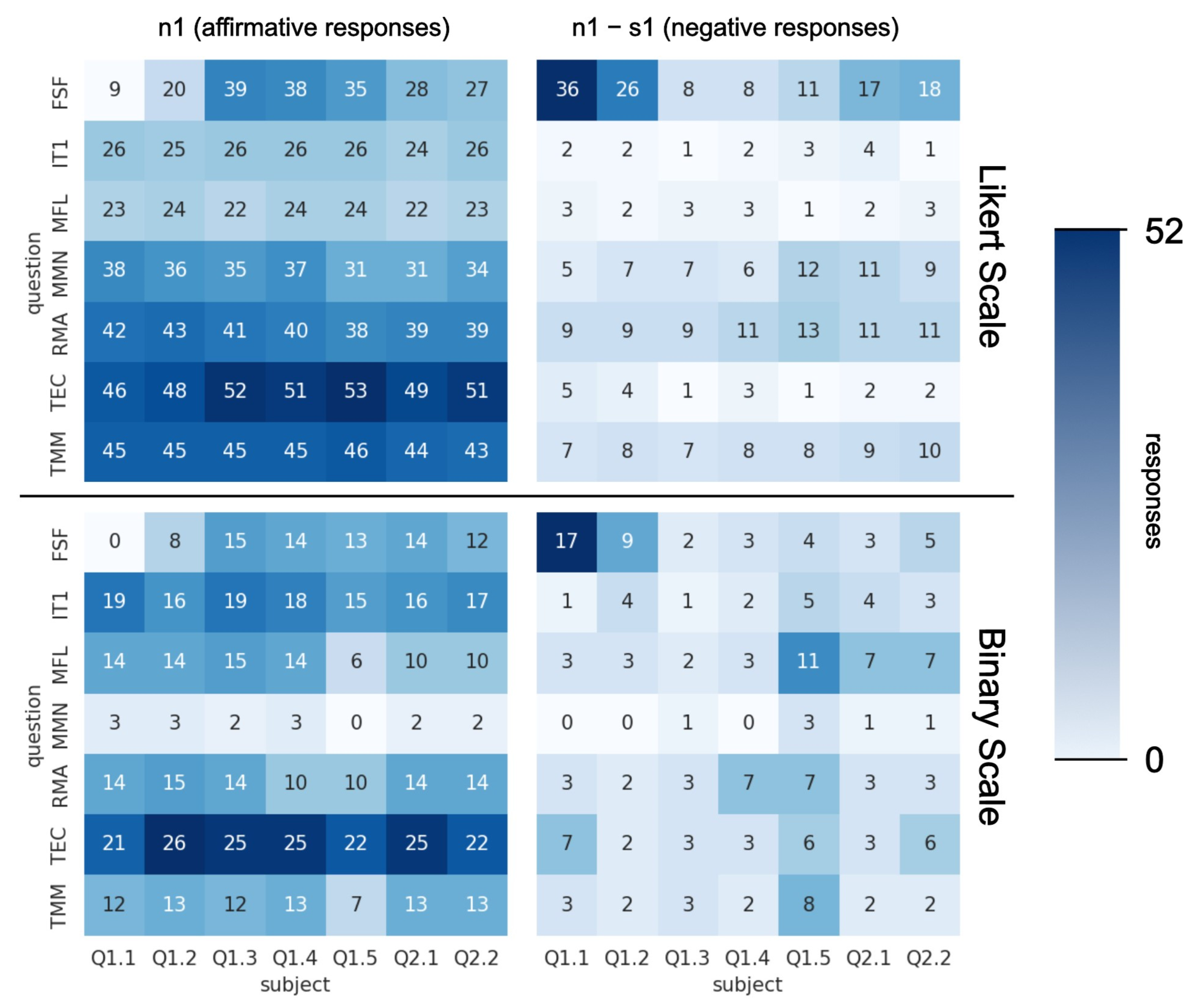
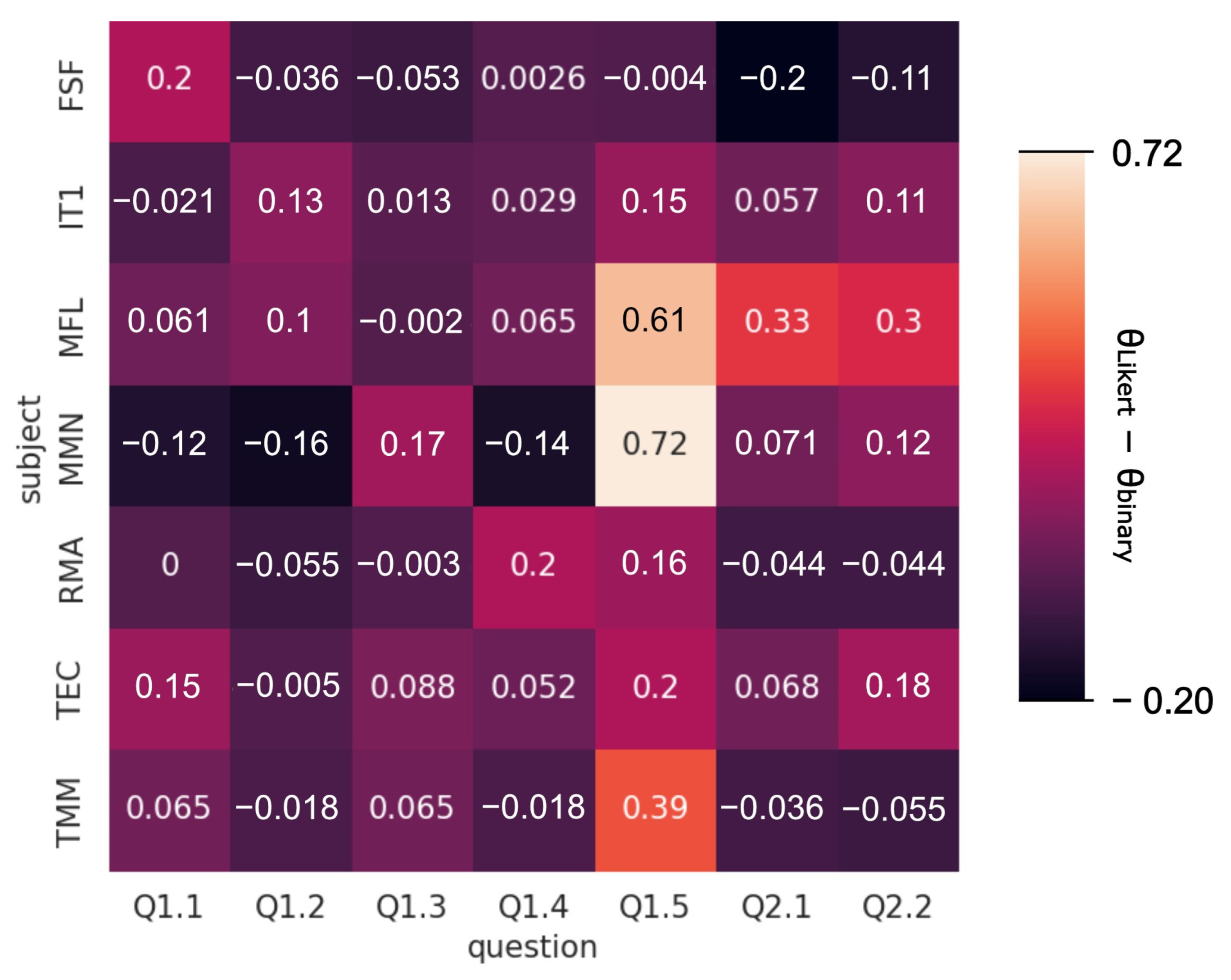
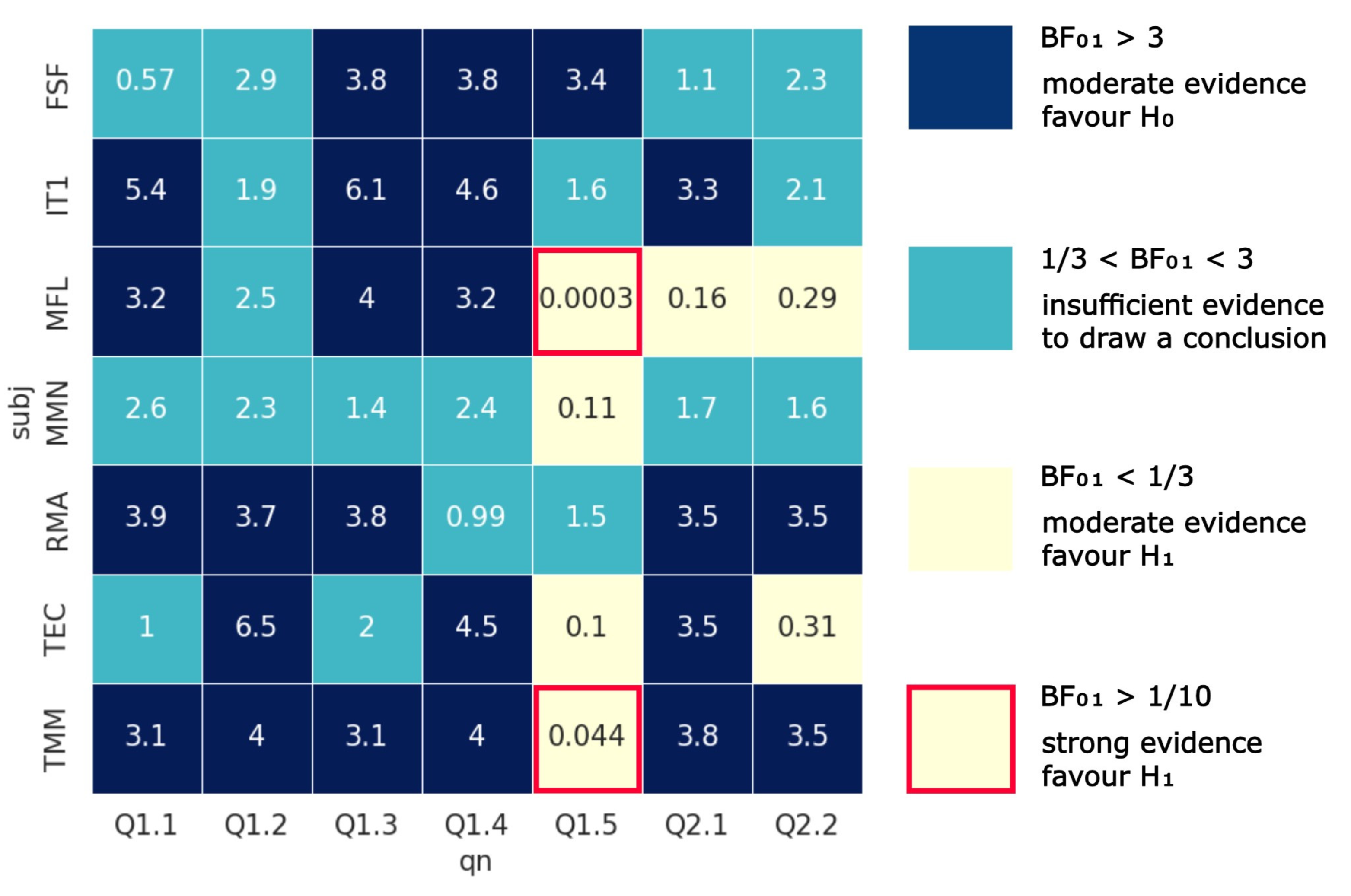
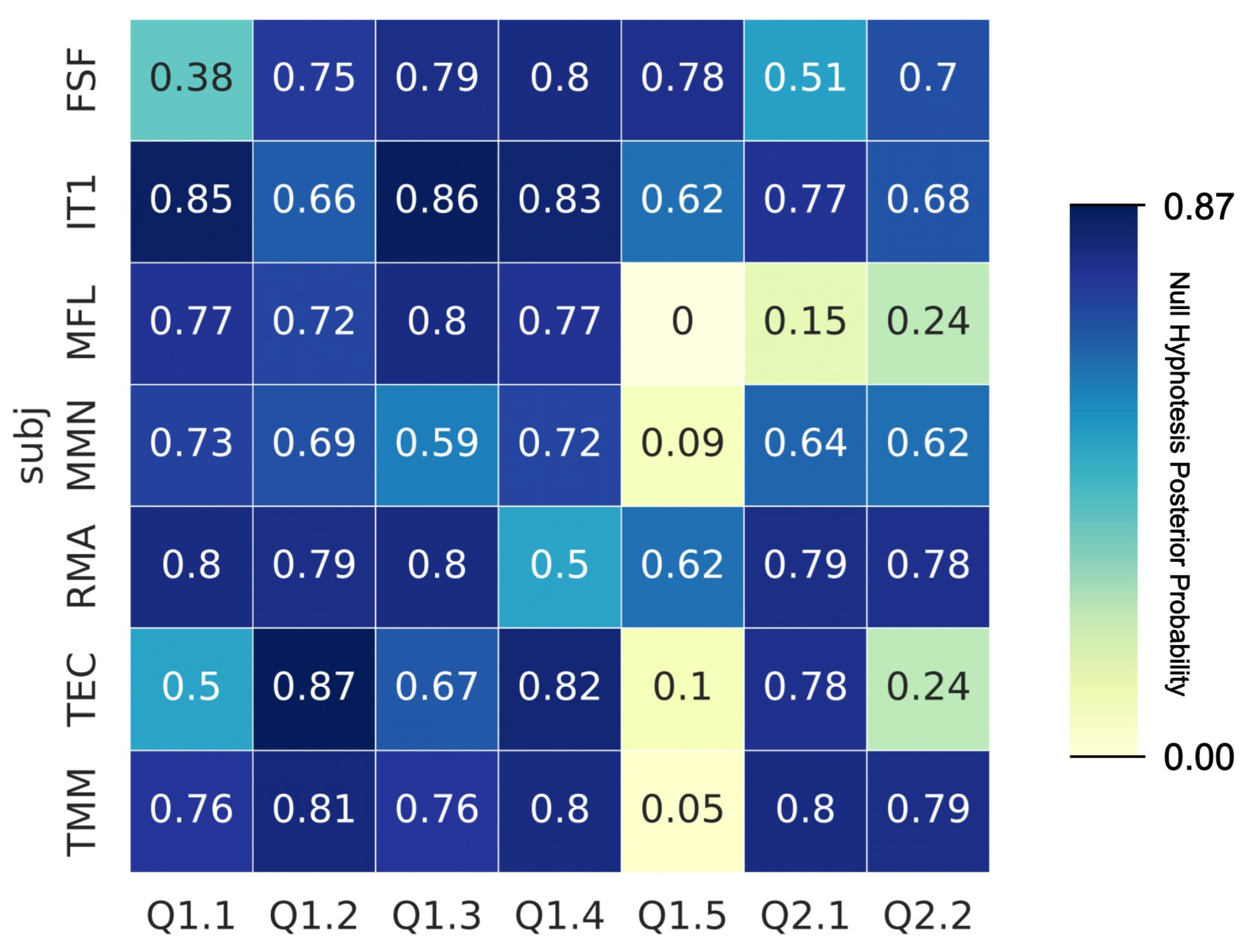
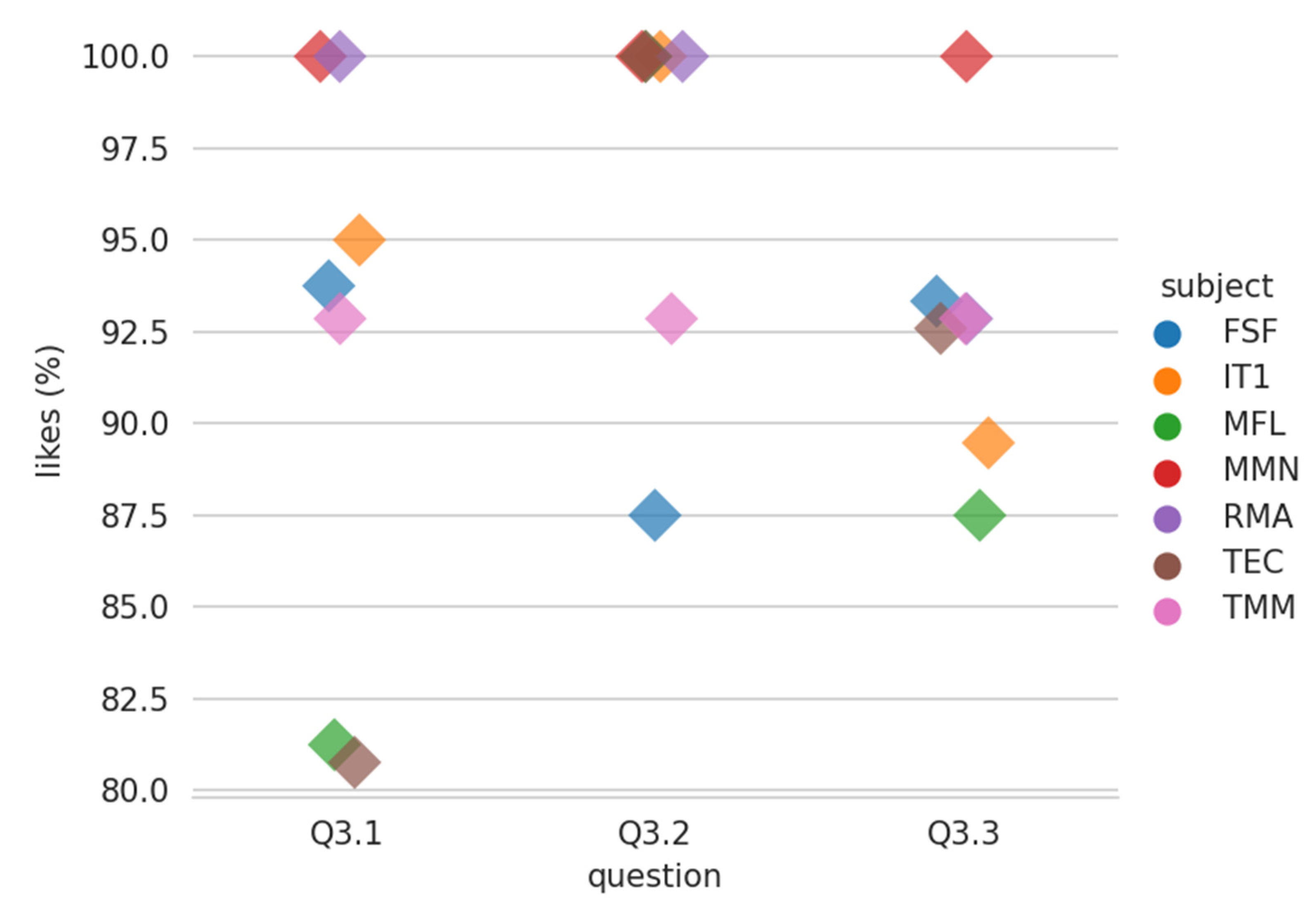
| Label | Question |
|---|---|
| Q1.1 | This subject is important for my learning. |
| Q1.2 | The credits assigned to the subject are commensurate with the amount of work required to pass. |
| Q1.3 | The teaching guide (or program) of the subject is available and easily accessible. |
| Q1.4 | The teaching guide (or program) of the subject includes the objectives, contents, methodology, bibliography and evaluation system in an understandable and detailed way |
| Q1.5 | The coordination between teachers of the subject is adequate. |
| Q2.1 | The conditions (space, equipment, material, etc.) in which the teaching takes place are satisfactory as far as theoretical classes are concerned. |
| Q2.2 | The conditions (space, equipment, material, etc.) in which teaching takes place are satisfactory in terms of practical classes (laboratory, workshops, field classes…). |
| Label | Question |
|---|---|
| Q3.1 | I found the scale (“I like”/“I don’t like”) easier than the one usually used (1 to 5). |
| Q3.2 | I found the scale (“I like”/“I don’t like”) easier than the one usually used (1 to 5). |
| Q3.3 | I found the scale (“I like”/“I don’t like”) easier than the one usually used (1 to 5). |
Disclaimer/Publisher’s Note: The statements, opinions and data contained in all publications are solely those of the individual author(s) and contributor(s) and not of MDPI and/or the editor(s). MDPI and/or the editor(s) disclaim responsibility for any injury to people or property resulting from any ideas, methods, instructions or products referred to in the content. |
© 2024 by the authors. Licensee MDPI, Basel, Switzerland. This article is an open access article distributed under the terms and conditions of the Creative Commons Attribution (CC BY) license (https://creativecommons.org/licenses/by/4.0/).
Share and Cite
Suárez-García, A.; Álvarez-Hernández, M.; Arce, E.; Ribas, J.R. Exploring the Efficacy of Binary Surveys versus Likert Scales in Assessing Student Perspectives Using Bayesian Analysis. Appl. Sci. 2024, 14, 4189. https://doi.org/10.3390/app14104189
Suárez-García A, Álvarez-Hernández M, Arce E, Ribas JR. Exploring the Efficacy of Binary Surveys versus Likert Scales in Assessing Student Perspectives Using Bayesian Analysis. Applied Sciences. 2024; 14(10):4189. https://doi.org/10.3390/app14104189
Chicago/Turabian StyleSuárez-García, Andrés, María Álvarez-Hernández, Elena Arce, and José Roberto Ribas. 2024. "Exploring the Efficacy of Binary Surveys versus Likert Scales in Assessing Student Perspectives Using Bayesian Analysis" Applied Sciences 14, no. 10: 4189. https://doi.org/10.3390/app14104189
APA StyleSuárez-García, A., Álvarez-Hernández, M., Arce, E., & Ribas, J. R. (2024). Exploring the Efficacy of Binary Surveys versus Likert Scales in Assessing Student Perspectives Using Bayesian Analysis. Applied Sciences, 14(10), 4189. https://doi.org/10.3390/app14104189







